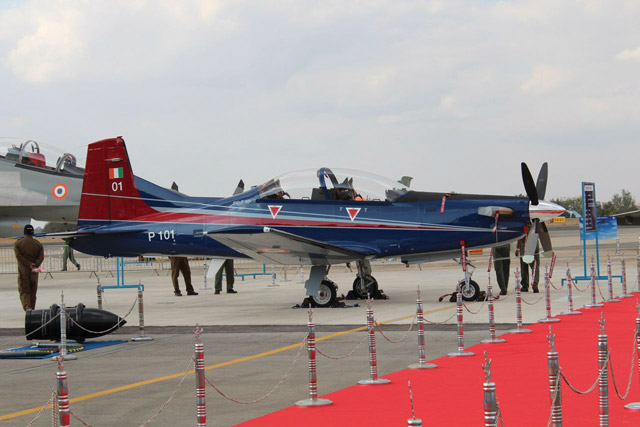The Indian air force's most senior officer has cast further doubt on the future of the Hindustan Aeronautics (HAL) HTT-40 basic trainer, and also criticised the company's HJT-36 Sitara jet trainer during a media briefing at the Aero India show.
Although bad relations between HAL and its biggest customer, the Indian air force, have been reported for years, the event at Yelahanka air base, near Bengaluru, gave a unique glimpse into the differences between the two parties.
"We have the Pilatus PC-7 MkII trainer now," says Air Chief Marshal NAK Browne. "It is a fully proven trainer flown by many countries globally. HAL's project to make [the HTT-40] from scratch means that costs are bound to be higher. The Indian air force would also have to pay for research and development. In our view there is no need for this. We need to stick to one trainer, and we have advised the government of this."
This is not the first time the air force has questioned the HTT-40. In late 2012, media reports indicated the service had rejected the trainer. Moreover, New Delhi is obtaining 75 Pilatus PC-7 MkIIs off the shelf after conducting a competition for a new basic trainer.
 |
|---|
| Ellis Taylor/Flightglobal |
In January 2013, widespread Indian media reports claimed a 30-aircraft follow-on purchase had also been confirmed, but a Pilatus representative at Aero India told Flightglobal the reports are false.
Browne also criticised HAL's developmental HJT-36, referred to generally as the 'IJT', or intermediate jet trainer. The project has suffered years of delays, and several well-publicised accidents. Browne says the HJT-36's powerplant, the Russian-made NPO Saturn AL-55I afterburning turbofan, is of particular concern, with a time before overhaul of only 200h.
Flightglobal's World Air Forces directory for 2013 states that New Delhi has ordered 16 HJT-36s, which will fit mid-way between a basic trainer and the air force's BAE Systems Hawk 132 advanced jet trainers, which HAL builds under licence.
Browne's comments were especially notable, because he made them only 2h after a media briefing by HAL chairman RK Tyagi.
Tyagi said it would be cheaper for New Delhi to create an indigenous basic trainer with the supply chain located mainly in India. He also defended the HJT-36, noting it has conducted 647 test flights, of which 185 took place in 2012. The type also conducted 45 flights in January 2013, including night flights, he adds.
"We are confident that the [HJT-36] can achieve its IOC [initial operating capability] in December this year," Tyagi says.
During this year's show, the air force's first PC-7 MkII appeared in the static park, while HAL displayed a full-sized mock-up of the HTT-40 at its stand.
Shiv Aroor, author of the Livefist defence blog, takes issue with the air force's decision to display the Pilatus aircraft.
"Why in the world would you display a trainer aircraft that represents - if nothing else - India's complete inability to build even a basic airplane for its armed forces," writes Aroor in a blog post. "It occurred to me then that this is probably precisely why the Indian air force has the PC-7 on the flight line. As a mocking jibe, perhaps, at HAL which will unveil a mock-up of its all-but-dead HTT-40 basic trainer concept."
Irrespective of the air force's views toward HAL it is, to a large degree, stuck with the government-owned aircraft maker for decades to come. HAL is the prime contractor for the future fifth-generation fighter aircraft, based on the Sukhoi PAK-FA/T-50 and being co-developed by the companies.
HAL will also produce 108 aircraft under the medium multi-role combat aircraft contract, with Dassault in final negotiations with New Delhi for a total 126-unit order for its Rafale. These are but two of HAL's numerous air force programmes.
"We have a functional relationship with HAL," says Browne. "The air force relies on HAL not only for aircraft but also for upgrades and other modifications. This relationship goes back decades to the time HAL was formed."
Source: Flight International










































